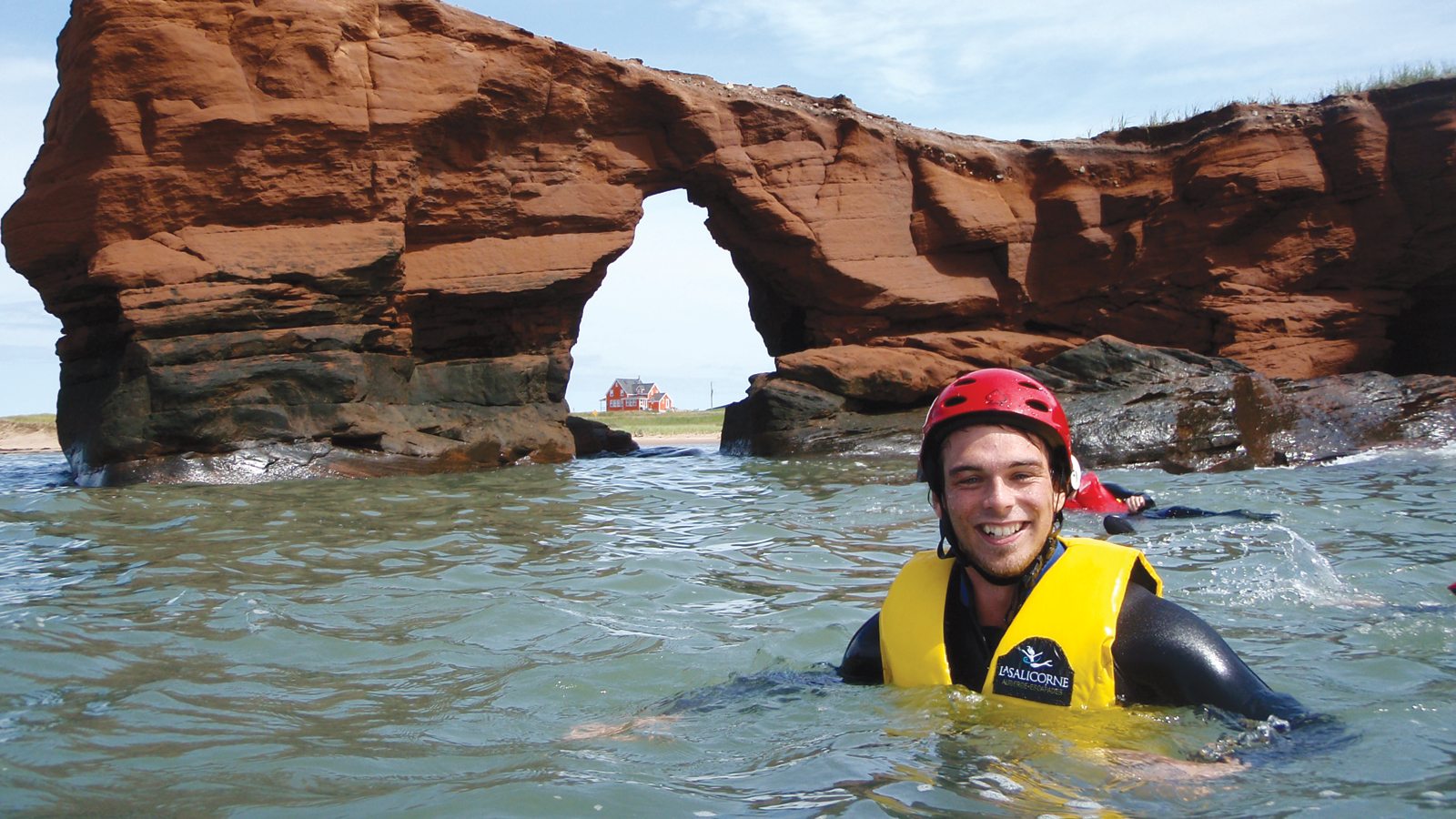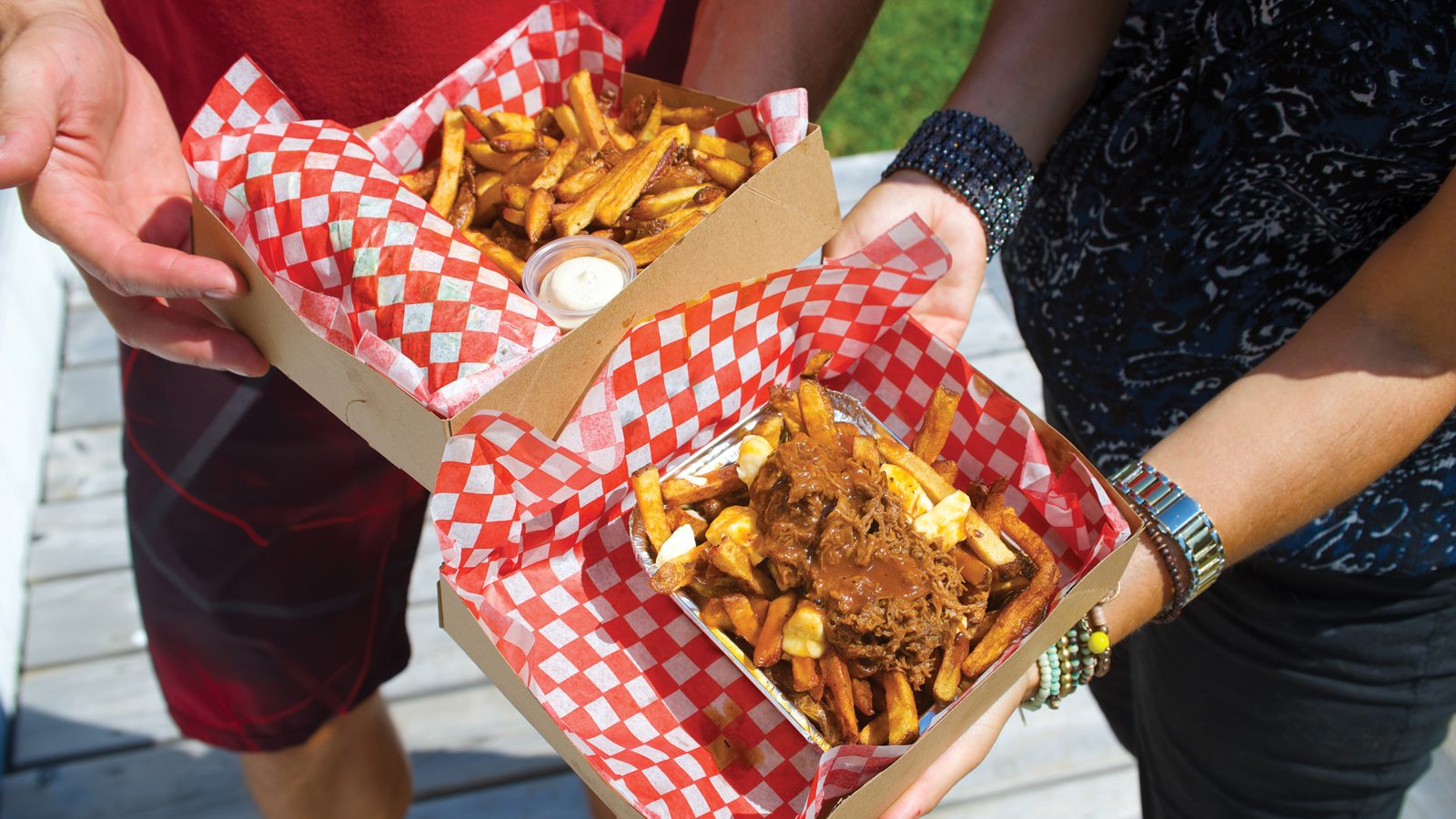Language is hardly the only thing that makes Quebec unique. The province is arguably Canada’s most geographically diverse, with everything from Arctic tundra to Appalachian frontier to oceanic vistas, plus très chic urban centres. Whatever the season and wherever you find yourself, must-try activities and one-of-a-kind attractions, like the dozen collected here, guarantee bons temps in la belle province. And don’t forget to contact an AMA Travel Counsellor to discover even more ways to experience Quebec this year and beyond.
SOAKS & SIGHTS
INDULGE AT A RIVERSIDE SPA
Ships in city harbours tend to evoke images of industry and commerce: big vessels hauling all manner of cargo; smaller boats packed bow to stern with commuters, sightseers and pleasure cruisers. But at least one ship presents an intriguing alternative.
Moored at Montreal’s Old Port, Bota Bota moves its patrons “between two water worlds.” It’s a serene Scandinavian spa with hot and cold pools—plus saunas, steam rooms, and even yoga and pilates classes—on the bustling banks of the St. Lawrence River.
Bota Bota is the brainchild of the Émond family. “We [my dad and I] were looking for a place to have a spa by water,” co-owner Geneviève Émond says. “It’s urban, but it brings the sense of being outside.” In this case, that means views of the geometric Habitat 67 housing complex, historic Old Montreal and more.
Montreal-based Sid Lee Architecture executed the Émonds’ vision, turning the vessel—formerly a commuter ferry and later, a showboat with live theatre—into
a unique spa environment.
The design is intrinsic to the experience: The deepest bowels of the boat, where I change into my bathing suit, are darker, and foster an introspective state. It gets brighter as I ascend—up past the treatment rooms’ illuminated 678 portholes, and then to the top two levels, where sunlight floods through floor-to-ceiling windows.
It’s in the clear light of day that I begin the water circuit, first relaxing on the Sunshine Deck, then moving to the sauna, where my pores dilate and my blood pressure rises. After that it’s whoosh—into the cold plunge pool, heart pumping, pores closing up. Finally, I wind down on the Middle Deck, my heart rate gradually returning to normal.
It’s a rejuvenating journey that I repeat twice more. At Bota Bota, I may be in port, but I’m hardly anchored. Like the river, I’m flowing free. —Diana Ballon
DISCOVER AN ENCHANTED FOREST
As the summer sun sets, a beguiling new world is revealed at the Parc de la Gorge de Coaticook. From June to October, the Eastern Townships destination uses cutting-edge lighting, video, sound and production design to create its “Foresta Lumina,” a nighttime realm inspired by Quebecois legends and woodland mythology. Both beautiful and uncanny—and boasting the continent’s longest suspension footbridge—this is definitely a path worth taking.
FALL FOR THE FOLIAGE
The vast canvas of Quebec’s Laurentian region is especially splashy when autumn coaxes brilliant colours from the mountainside maples, oaks, birches and basswoods. Famed Mont Tremblant boasts particularly stunning scenery: Take a gondola ride to the summit and its panoramic vista, or hook up with a zipline tour for even more exhilarating views.
OUTDOOR EXPLOITS

SWIM IN SEA CAVES
Normally I’d feel a little odd wearing a wetsuit on a bus. Fortunately on this day I’m not alone: 20 other passengers are similarly attired, and we’re all about to have a most unusual adventure.
In the Gulf of St. Lawrence, Quebec’s Magdalen Islands have a well-deserved reputation as one of Canada’s top aquatic playgrounds. The archipelago boasts world-class sea kayaking, sailing and windsurfing, but one outfitter, La Salicorne, also gives visitors the chance to try something rather less expected: swimming in sea caves along the Ile de la Grande Entrée’s sandstone-cliffed coastline.
Our bus arrives at the beach and we pull on life jackets and helmets before hitting the water. The jackets and wetsuits make us super buoyant, so our guides provide tips on propelling ourselves through the heaving ocean swell. Then we splash our way along the shore to our first cave.
Getting past the entrance isn’t easy—incoming waves carry us in through the opening, then outgoing waves drag us back out. Once we’ve struggled inside, we can relax and explore the cave’s quiet, dark interior. Then we push through the surf to the bright sunshine outside.
We visit more than a dozen distinct caves during our two-hour tour. The aptly named Washing Machine spins us around as though we’re on a rinse cycle. We access the Confessional by swimming underwater through a mostly submerged entrance hole.
For me, the most memorable cave is the Dragon’s Lair, the deepest one we enter. It eventually narrows into a thin crack, and then, after a tight squeeze lasting about six metres, widens again into an eerily black chamber. Just half a minute passes before claustrophobia forces me to leave. For a few seconds, as I squirm back through the slim passage, I’m feeling a little panicked. But then I see the light again, and I’m ready for another cave. —Clarke Thomas
EXPLORE PRISTINE WILDERNESS
Northern Quebec has vast unspoiled territory to discover. But you’ll need an expert navigator. Try a nine-day trek with Inuit guides in Kuururjuaq National Park, one of Nunavik’s most scenic spaces. Following in the footsteps of their ancestors, the guides help guests cross the tundra by dog sled, snowmobile, skis and snowshoes while reconnecting with nature at its most rugged.
MAKE AN EXTREME DESCENT
With more than two-dozen rugged peaks at least 1,000 metres high, the Chic-Choc Mountains present a challenge for skilled downhillers. From December through April, the Matane and Chic-Chocs wildlife reserves and Gaspésie National Park open up to backcountry skiers seeking the thrill of carving through deep virgin snow.
FOOD & DRINK

EAT YOUR WAY AROUND AN ISLAND
My tour of Quebec’s Île d’Orléans includes croissants, fried cheese and poutine, but it’s the scent of lavender that lingers. Often called the “Garden of Quebec,” the island in the St. Lawrence River has been at the heart of Quebecois cuisine for hundreds of years. Today, the best way to enjoy it is by driving the Chemin Royal ring road. Keep your windows down for the full olfactory effect.
My trip starts with superb pastries at La Boulange. Though it’s a fair distance northeast of the lone bridge from the mainland, an early arrival is important. Lineups form quickly here, and some of the specialties—like the flaky pain au chocolat and rich maple nut brioche—can and do sell out.
The island’s fromagerie is similarly in demand. A unique gastro-historical experience, its staff dress in period costume and use a 17th-century recipe to replicate North America’s first cheese. One version, Le Paillasson, is fried on a griddle to give it a chewy yet creamy texture.
RELATED CONTENT
Have a savoury stay in Montreal by visiting the city’s many bistros, bakeries, fresh food markets and more
Montreal gets the lion’s share of the poutine press, but I make a point to visit waterfowl farm La Ferme d’Oc, and its on-site La Roulotte du Coin poutinerie, for its delicious take on the iconic snack—made with hyper-local ingredients, naturally. Crisp, decadent duck fat fries almost render superfluous the cheese curds, gravy and foie gras pâté topping. I’m struck by how clearly the farmer underlines his connection to thoughtful, small-scale production by placing a pen of geese front and centre, right beside the picnic tables.
And that lavender smell? It’s most pervasive near Seigneurie de l’Île d’Orléans, which devotes four hectares to the aromatic herb. It’s farms like these that earn the island its reputation as the region’s vegetable garden by supplying Quebec City with a significant portion of its produce. Of course, foodies go directly to the source: By early summer the roadsides are lined with fruit stands selling fresh berries. Or visit Ferme Léonce Plante to pick some of your own, including a unique-to-the-island strawberry variety that’s said to have particularly high levels of antioxidants. —David Ort
GET GLUTTONOUS
Chef Martin Picard dishes upscale yet unapologetically Quebecois fare at Au Pied du Cochon. But for an even more indulgent meal, reserve a seat at Picard’s Cabane à Sucre, a rustic outpost open during the spring maple syrup season and autumn harvest. Wear loose-fitting pants: The massive menu changes on a regular basis, but is reliably stuffed with fatty meats, local cheeses and gooey syrup.
DOWN CRAFT DRAUGHTS
The unique character of Montreal—proud of its history yet keenly contemporary—is reflected in its artisan beer scene, so try a Montreal Craft Beer Tour as a way to sample the city. In addition to tasting exclusive house-made ales with Quebec cheeses, charcuterie and chocolates, guests also get an insider’s perspective on local architecture and attractions.
UNIQUE STAYS

SLEEP IN A TREEHOUSE
I wiggle my toes from beneath a cocoon of blankets and pull the sheets from over my eyes. Sunlight streams through nearby windows. It’s morning, but I’m too comfy to move. The promise of tea, however, rouses me; I climb down the chunky wooden ladder from my loft and pad across the sun-bathed room.
Opening the front door, I’m met by a full basket of homemade waffles, bread, fruit, jams, maple syrup, butter, juice, and hot tea and coffee. It’s being hoisted by a rope and pulley system from the ground below. Breakfast has arrived.
I’ve just spent the night at Les Toits du Monde (“The Roofs of the World”), a beautifully constructed treehouse deep in the woods of Nominingue, two hours north of Montreal. Hovering almost five metres above the forest floor, between swaying maples and rustling birches, the elaborate, eco-friendly lodging recalls childhood fantasies but adds grown-up amenities, including a stove, shower and composting toilet.
Brought to life by owners Dior Fall and Sylvain Neuenschwander, former computer engineers with a passion for the great outdoors, the Les Toits site also boasts a tipi, Mongolian yurt and even a hobbit house.
RELATED CONTENT
Discover even more unique accommodations around the world
Four of us had spent the previous night hanging out in the spacious main floor of the treehouse, beneath its second-level loft. We put together a rustic feast in the small kitchen. After dinner, we enjoyed a couple of drinks, roasted marshmallows on the woodstove and ran across the house’s bouncing rope bridges, celebrating our seemingly enchanted night. Eventually the wide porch beckoned: we sunk quietly into our chairs to gaze into the starry night.
Now I’ve finished breakfast and we’ve all packed our bags. As we drive away I indulge one last look at the Laurentians, our lush, scenic home for one night, and promise myself that I’ll soon return to the backcountry wonderland that is Les Toits du Monde. —Seattle Dredge
SNUGGLE UP IN AN ICE HOTEL
Despite the chilly environs, you’re sure to be received warmly at the Hôtel de Glace. North America’s only inn made entirely of snow and ice is open from January to late March, with 40-plus igloo-like rooms. Sip a cocktail from an ice glass and unwind at the outdoor spa before tucking in beneath cozy comforters. Curious but less inclined to brave the cold? The hotel, just outside Quebec City, also offers guided architectural and behind-the-scenes tours.
GO GLAMPING
A number of Quebec’s wilderness refuges now encourage reconnecting with nature without giving up modern comforts. So-called EXP cabins, like those at Mont Mégantic National Park, are chic yet sustainable “microhabitats” designed for couples seeking a more convenient camping trip. Cabins are equipped with a kitchen, bathroom and sleeping quarters, but panoramic floor-to-ceiling windows bring the outside in.
